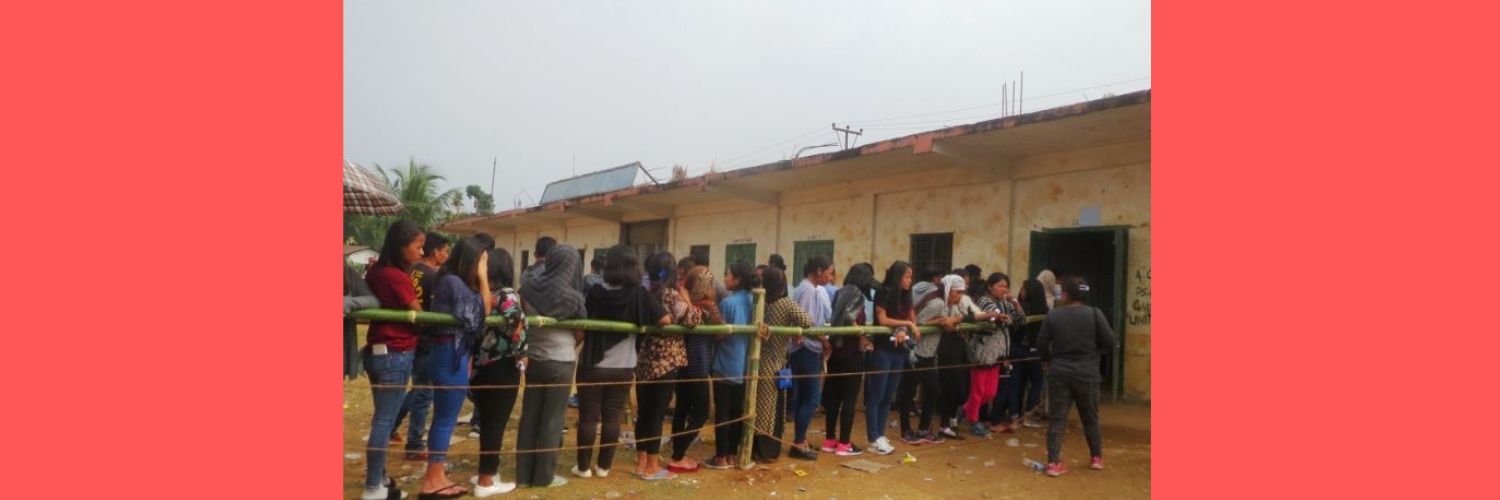
By Aheli Moitra
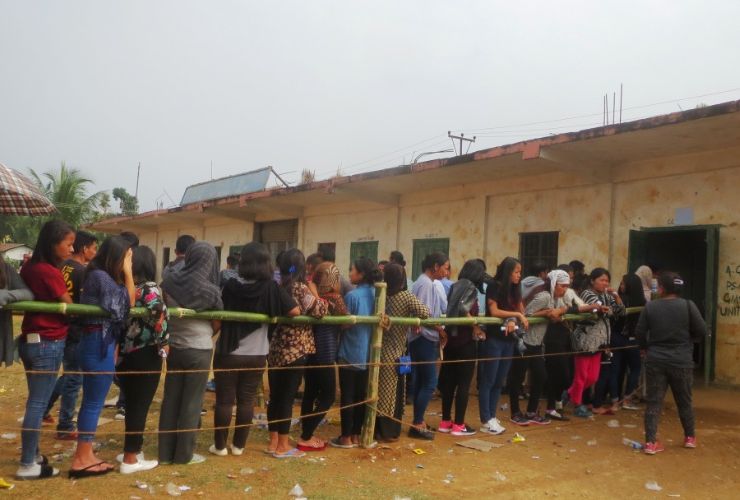
For representational purpose only. Women queue up to vote during the 2018 election in Nagaland.
Nagaland votes on February 27
Nagaland got its first ever female Rajya Sabha MP, Phangnon Konyak, in 2022. She is the second woman from Nagaland to ever hold a parliamentary position since the state’s formation in 1963 (Rano M Shaiza was first elected to the Lok Sabha in 1977). Konyak’s appointment was not without controversy, made in the immediate aftermath of the Oting killings. The issue of women political candidates is an issue divisive enough in Nagaland to have brought down a government in recent times. This means every woman who stands for election in the state holds potentially groundbreaking significance.
Four women are among the 182 candidates contesting elections for 59 seats in the 14th Nagaland Legislative Assembly (NLA) on February 27, 2023 (one BJP legislator has already been elected unopposed). Back in 2018, there were five women among 196 candidates; none of them were elected to the 60-member Assembly. With 13,17,632 eligible voters, Nagaland has an almost equal ratio of women to men voters (numbers tilt slightly in favour of men).
This time all the women candidates are first time contestants. Several parties in Nagaland, whether regional or national, do not give women more than one chance to contest polls, even though they back losing male candidates multiple times in other constituencies. Women are not considered winning horses. The Bharatiya Janata Party (BJP), the Indian National Congress (INC), and Nationalist Democratic Progressive Party (NDPP) have all issued tickets to first time women candidates in 2023, not the ones they had fielded during the last NLA election in 2018. The only exception seems to be Rhakila, who contested twice (2013 and 2018) on a BJP ticket and earlier on an NCP ticket, making her a three-time contestant (but she lost all three times). Reasons galore are listed for not considering women as serious electoral candidates in Nagaland, including the absence of women in traditional institutions in villages or other political institutions (even though women do hold positions in the state’s bureaucracy, across ministries and departments).
In the run-up to the 2023 elections, the INC is the only political party with women spokespersons even though none of them is from Nagaland. The much-needed oppositional discourse that the INC produced in Nagaland, widely covered by the local media, came from non-Naga women sent from ‘mainland India’, including Sujata Paul, Mahima Singh and Supriya Shrinate.
Nagaland-based political parties do not have women spokespersons. Nor do the parties let the more capable women members speak on their behalf. The only time BJP’s Rajya Sabha MP, Phangnon Konyak, was able to speak in public was during Amit Shah’s campaign rally in Mon district. Her job: to translate the visiting political leader’s Hindi speech to Nagamese. The BJP also has a woman media coordinator, Sapralu Nyekha. She spoke at a press conference to defend the right of one of its campaigners, John Barla, to utter Christian slogans alongside Hindutva ones, which was strongly objected to by church institutions in Nagaland. Soon afterwards she was censured by Nagaland state journalists’ bodies for using abusive language while communicating with them.
Right to representation
Gender is often a non-issue in Nagaland’s media, too. Local newspapers, digital and cable news channels cover women as part of the mainframe of indigeneity and church-led discourse (a prominent part of media discourse in Nagaland). Gender issues are missing though. Women feature marginally as a category in need of better governance, as beneficiaries of constitutional rights, land rights and government schemes. Even the local civil society organisation focusing on ‘motherhood’ promotes women’s activism vis a vis children, not about women or gender-related issues.
The Naga Mothers’ Association (NMA) has fought legal cases demanding women’s right to representation in Urban Local Bodies (ULBs) over the past decade. Since 2006, when the Nagaland Municipal Act introduced 33 per cent reservation for women in civic bodies, the Nagaland state government has been unable to conduct local elections. The state is yet to execute the Supreme Court’s orders to announce and conduct elections to these bodies. The NMA also put out an appeal for political parties to issue party tickets to women candidates in the 14th NLA elections and to put the statements about ‘women’s empowerment’ in their manifestos into practice.
On February 15, all newspapers in the state reported the Nagaland Chief Minister’s claims about conducting elections to ULBs in March 2023, with reservations for women as legally mandated. No newspaper questioned the timing of this proclamation right before the Assembly elections. The Neiphiu Rio government had already announced in March 2022 that it had reached a ‘collective understanding’ with Naga civil society to hold the ULB polls with the required reservation for women. Yet, soon afterwards, the Rio government once again asked the Supreme Court of India to allow the ULB polls to be deferred to 2023. The recent announcement is clearly being used for campaigning purposes in the context of elections to the 14th NLA.
In the background is the buzz of memories of the 2017 fiasco around the issue of women and ULBs. At that time, civil society-led protests against elections to the Urban Local Bodies with 33 per cent reservation of seats for women brought down the TR Zeliang-led government. This had paved the way for the current Chief Minister, Neiphiu Rio, to take back the chief ministership that he had earlier abandoned in the hope of securing a cabinet berth in the Union Government.
Now, CM Rio is making the same promise during his election campaign about setting up and announcing elections to the ULBs in March this year. With wide coverage given to this aspect of the campaign, the Nagaland Post published an editorial on February 16 recollecting the history of how the present reservation crisis developed in the state. It questioned whether or not the reservation will serve any purpose at all. On February 23, The Morung Express published an editorial on the same matter. Given the state government’s consistent disregard for the Supreme Court’s orders, the editorial questioned the state government’s seriousness about the constitutional mandate for the representation of women in governance. It is natural to wonder why the Supreme Court appears incapable of holding the state responsible for upholding the law.
Women in media during election season
The advertisements of political parties on the front pages of newspapers make the gender imbalance in political representation very visible indeed. They showcase the boys’ club that elections in Nagaland are. It appears that women cannot make decisions on peace, development or progress, denied a voice on matters related to issues of governance in the state.
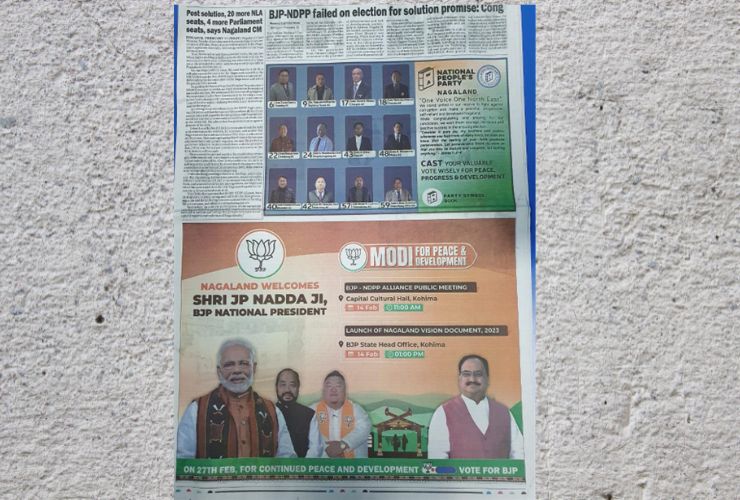
On the inside pages, the local media’s coverage of women during elections includes reports on campaigns and introductions to the rare women candidate.
On February 7 this year, Nagaland Page published a report on the start of the NDPP woman candidate’s campaign. On February 13, the Eastern Mirror introduced the four candidates in a front page anchor feature, with brief interviews with each of them, giving readers a sense of who these women are: Hekani Jakhalu Kense (NDPP) from 3 Dimapur-III A/C, Rosy Thomson (INC) from 6 Tening A/C, Salhoutuonuo Kruse (NDPP) from 8 Western Angami A/C, and Kahuli Sema (BJP) from 32 Atoizu A/C.
The campaign trails of Hekani Jakhalu Kense, Kahuli Sema and Salhoutuonuo Kruse have been given a fair share in the newspapers, with the chief ministers of Nagaland and Assam campaigning for them. The Morung Express did a short feature, with reflections from a previous woman candidate, as well as Salhoutunuo Kruse and Rosy Thomson, on how difficult it is for women to contest polls.
On February 14, The Morung Express carried a page 7 feature on how gender equity and empowerment remain mere ‘catchphrases’ among electoral candidates and in party manifestos. That this piece was published on the second last page of the newspaper shows how insignificant gender issues are for the media.
This is an election flooded by ‘money and muscle power’ (not unlike past elections in the state, or elections elsewhere in the Indian Union) and an array of illegitimate means that have ultimately driven the ‘clean election’ campaign championed by the major churches of Nagaland that have come together under the banner of the Nagaland Joint Christian Forum. Under the wide ambit of this campaign, women in Phek district have started their own campaign to check the flow of liquor by setting up their own check gates, in addition to police checks throughout the state. Nagaland Page covered this as lead news on their front page on February 20. The Eastern Mirror published a feature on the Chakhesang Mothers’ Association’s electioneering efforts on February 25.
On February 21, Nagaland Page also became the only newspaper to critique the taken-for-granted goodness and usefulness of the clean election Christian campaign, through a scathing opinion piece by its Editor, Monalisa Changkija, the only woman editor of a newspaper in Nagaland. On February 23, the Mokokchung Press Club condemned the ‘frisking’ of media persons by such women’s groups, highlighting the fact that vigilantism, whether by women or men, may not be the best way to check illegal electoral practices.
Electoral malpractices that flout the Model Code of Conduct in place during elections include the coverage of elections by local broadcast news channels and several YouTube channels. An editorial in The Morung Express hinted at how such platforms and the news they spread without any accountability mechanism could lead to trouble, while another editorial called out the problems directly created by ‘Youtubers’ in the election scenario. Ultimately, the Nagaland Page did a front page story on how a broadcast news channel in the state openly flouted norms of journalistic standards and ethics in support of the BJP. The channel is owned by the family of one of the more popular BJP candidates in Dimapur, the state’s commercial capital.
Manifestos
The Morung Express published a feature on February 25 comparing the manifestos of the contesting political parties, with a section on how each of them present ‘women welfare’. Several parties have pledged commitment to the empowerment of women, with the BJP specifically making promises such as ‘free Scooty for meritorious college girls’ and ‘free education for girls till PG’ in its Vision Document 2023 (also carried as advertisements on the front page of every major newspaper in the state). On February 15, Nagaland Post, Eastern Mirror and Nagaland Page published detailed reports on the BJP manifesto, which includes benefits for the girl child under schemes named after prominent women leaders of Nagaland, including Neidonuo Angami and Temsula Ao. This perhaps lends the BJP legitimacy in a state where its Hindutva agenda faces pushback from Christian institutions.
With crores of rupees attached to these schematic imaginations, the manifesto promises made by other parties on gender issues have been largely ignored by local media, but for good reason. They remain vague, noncommittal and are checkbox exercises at best. For instance, the NDPP states that it stands for ‘women’s empowerment’ and reservation, but makes no specific claims about what it plans to do to achieve this (its ongoing back and forth with the Supreme Court on reservations for women in ULBs has been mentioned above). The INC does not mention how it plans to convince Naga apex institutions about their plans to implement the 33 per cent reservation for women in ULBs that it confidently promises. The Naga People’s Front (NPF) mentions ‘women’s empowerment’ through appropriate steps for women to gain inheritance rights to acquired property and for the ‘gradual participation’ of women in Naga decision making and customary law enforcement bodies, currently exclusively reserved for men. With none of the newspapers interrogating this claim, the issue, though pertinent and possibly contested, has remained a non-issue, too.
Abandoning women
While corruption mechanisms drawn from the mainland have been comfortably enabled into Nagaland state structures, women are forced to bear the impact of insecurities emerging from the in-limbo status of the Indo-Naga political talks. The protests against the ULB elections in 2017, for instance, included the argument from men that the land taxes expected to be paid to municipal and town councils would be unacceptable to Nagas. The Naga movement for self-determination was advanced on the premise that the Nagas will not pay land or income tax to the Indian government on the ground that the Nagas are owners and governors of their own land, a majority of which belongs to the communities.
While women are included in these communities, they are denied ownership to village land, often referred to as ‘traditional land’. While ‘acquired property’ in the cities are open to ownership by women, the inheritance of this sort of new ‘acquired’ property by women has sometimes been contested (the argument being that women will marry ‘outsiders’ and pass on their ownership to non-Nagas). These unsaid tenets are part of the Naga People’s Convention-led political agreement with the Government of India to join the Indian Union in 1960 through a 16-points agreement, which became basis for Article 371-A being inserted into the Constitution of India. This led to the formation of the Nagaland state in 1963. The Article guarantees the protection of the religious, social, customary and land practices of the Nagas. Brushed under these categories is the question of gender rights.
With the electorate in the state set to vote on Monday, February 27, some people in Nagaland are hopeful that at least one of the four current women candidates will win a seat. Whether or not this candidate will have the political will to highlight gender issues, particularly in terms of political representation, is unclear. Meanwhile, Nagaland’s newspapers have more than a mile to go in addressing gender issues in the state. With few reporters on the ground, who are overstretched by their responsibilities for daily reportage, one of the issues to drop off the pages of the state’s newspapers have been, and will continue to be, women.
Update: On the day of the elections (February 27), Nagaland Page published a report on women voters, candidates, their political potentials in the state, and roadblocks towards achieving those potentials. On the same day, The Morung Express published an informative feature on past women candidates from Nagaland. According to this, between 1969, when women first began to participate as candidates for the Nagaland Legislative Assembly polls, and 2023, when four women have stood for election, there has been a total of 21 female electoral candidates. None of them has won a seat.



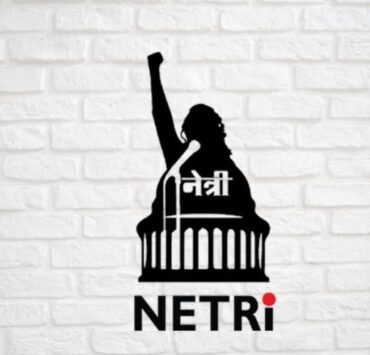
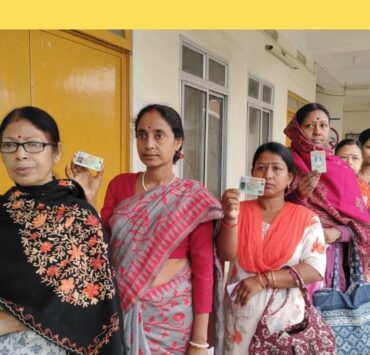
Very well written article. Waiting for the results whether woman candidate wins or not.